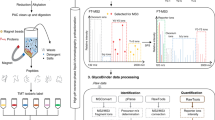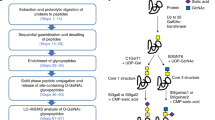Abstract
Glycosylation, which represents the most complex posttranslational modification (PTM) event during protein maturation, has a vital role in biological processes. Glycan biosynthesis is orchestrated by numerous glycosyltransferases, each displaying different selectivities for multiple reaction sites. The precise specificities of these enzymes have been difficult to study because of the lack of available substrates of defined structure and problems associated with the analyses. Moreover, the analysis of glycans is extremely difficult owing to the structural complexity of the glycan chain. Here we describe a new strategy for the fine characterization of enzyme specificity using substrate isotopomer assemblies. Because isotopomer assemblies contain a sugar residue that is position-specifically labeled with a stable isotope, we can use tandem mass spectrometry (MS/MS) to assign the structure of positional isomers generated by glycosylation. We demonstrated the analysis of substrate specificities of five β4-galactosyltransferases (β4GalT-I, -II, -III, -IV and -V) using our strategy.
This is a preview of subscription content, access via your institution
Access options
Subscribe to this journal
Receive 12 print issues and online access
$259.00 per year
only $21.58 per issue
Buy this article
- Purchase on Springer Link
- Instant access to full article PDF
Prices may be subject to local taxes which are calculated during checkout





Similar content being viewed by others
References
Varki, A. Biological roles of oligosaccharides: all of the theories are correct. Glycobiology 3, 97–130 (1993).
Rudd, P.M. et al. Glycosylation and the immune system. Science 291, 2370–2376 (2001).
Dove, A. The bittersweet promise of glycobiology. Nat. Biotechnol. 19, 913–917 (2001).
Ritchie, G.E. et al. Glycosylation and the complement system. Chem. Rev. 102, 305–320 (2002).
Haltiwanger, R.S. & Lowe, J.B. Role of glycosylation in development. Annu. Rev. Biochem. 73, 491–537 (2004).
Mitra, N. et al. N-linked oligosaccharides as outfitters for glycoprotein folding, form and function. Trends Biochem. Sci. 31, 156–163 (2006).
Shriver, Z., Raguram, S. & Sasisekharan, R. Glycomics: a pathway to a class of new and improved therapeutics. Nat. Rev. Drug Discov. 3, 863–873 (2004).
Raman, R. et al. Glycomics: an integrated systems approach to structure-function relationships of glycans. Nat. Methods 2, 817–824 (2005).
Comelli, E.M. A focused microarray approach to functional glycomics: transcriptional regulation of the glycome. Glycobiology 16, 117–131 (2006).
Paulson, J.C., Blixt, O. & Collins, B.E. Sweet spots in functional glycomics. Nat. Chem. Biol. 2, 238–248 (2006).
Taniguchi, N. Honke, K. & Fukuda, M. (Eds.) Handbook of Glycosyltransferases and Related Genes (Springer-Verlag, New York, 2001).
Narimatsu, H. Construction of a human glycogene library and comprehensive functional analysis. Glycoconj. J. 21, 17–24 (2004).
Tomiya, N. et al. Structural analysis of N-linked oligosaccharides by a combination of glycopeptidase, exoglycosidases, and high-performance liquid chromatography. Anal. Biochem. 163, 489–499 (1987).
Nakagawa, H. et al. Identification of neutral and sialyl N-linked oligosaccharide structures from human serum glycoproteins using three kinds of high-performance liquid chromatography. Anal. Biochem. 226, 130–138 (1995).
Takahashi, N. et al. Three-dimensional elution mapping of pyridylaminated N-linked neutral and sialyl oligosaccharides. Anal. Biochem. 226, 139–146 (1995).
Dell, A. & Morris, H.R. Glycoprotein structure determination by mass spectrometry. Science 291, 2351–2356 (2001).
Harvey, D.J. Proteomic analysis of glycosylation: structural determination of N- and O-linked glycans by mass spectrometry. Expert Rev. Proteomics 2, 87–101 (2005).
Kameyama, A. et al. A strategy for identification of oligosaccharide structures using observational multistage mass spectral library. Anal. Chem. 77, 4719–4725 (2005).
Zaia, J. Mass spectrometry of oligosaccharides. Mass Spectrom. Rev. 23, 161–227 (2004).
Szabo, P. et al. Synthesis of O-{2-deoxy-2-[(3R)-3-hydroxytetradecanamido]-β-D-glucopyranosyl 4-phosphate}-(1 → 6)-2-deoxy-2-[(3R)-3-hydroxytetradecanamido]-D-glucose. The monosaccharide route. Carbohydr. Res. 111, C9–C12 (1983).
Subramaniam, S. & Susana, N. Synthesis of glycosyl phosphates and azides. Carbohydr. Res. 223, 169–185 (1992).
Moffat, J.G. Sugar nucleotide synthesis by the phosphoromorpholidate procedure. Methods Enzymol. 8, 136–142 (1966).
Wittmann, V. & Wong, C-H. 1H-Tetrazole as catalyst in phosphomorpholidate coupling reactions: efficient synthesis of GDP-fucose, GDP-mannose, and UDP-galactose. J. Org. Chem. 62, 2144–2147 (1997).
Hase, S. et al. Structure analyses of oligosaccharides by tagging of the reducing end sugars with a fluorescent compound. Biochem. Biophys. Res. Commun. 85, 257–263 (1978).
St. Hilaire, P.M. & Meldal, M. Glycopeptide and oligosaccharide libraries. Angew. Chem. Int. Ed. 39, 1162–1179 (2000).
Holemann, A. & Seeberger, P.H. Carbohydrate diversity: synthesis of glycoconjugates and complex carbohydrates. Curr. Opin. Biotechnol. 15, 615–622 (2004).
Ito, H. et al. Molecular-weight-tagged glycopeptide library: efficient construction and applications. Angew. Chem. Int. Ed. 44, 4547–4549 (2005).
Jefferis, R. Glycosylation of recombinant antibody therapeutics. Biotechnol. Prog. 21, 11–16 (2005).
Elliott, S. et al. Enhancement of therapeutic protein in vivo activities through glycoengineering. Nat. Biotechnol. 21, 414–421 (2003).
Shinkawa, T. et al. The absence of fucose but not the presence of galactose or bisecting N-acetylglucosamine of human IgG1 complex-type oligosaccharides shows the critical role of enhancing antibody-dependent cellular cytotoxicity. J. Biol. Chem. 278, 3466–3473 (2003).
Acknowledgements
We thank K. Kiyohara for assistance with preparation of enzymes. This work was performed as a part of the R&D Project of the Industrial Science and Technology Frontier Program supported by the New Energy and Industrial Technology Development Organization (NEDO).
Author information
Authors and Affiliations
Corresponding author
Ethics declarations
Competing interests
The authors declare no competing financial interests.
Supplementary information
Supplementary Fig. 1
Summary of the strategy used to determine the Gal-attachment sites of the reaction products by a tandem MS technique. (PDF 2497 kb)
Supplementary Fig. 2
Time-course of galactosylation by human β4GalTs. (PDF 3904 kb)
Supplementary Fig. 3
Analysis of the product generated from the fucosylation of bi-antennary N-glycan (1) with recombinant human FUT2 (α1,2 fucosyltransferase). (PDF 1334 kb)
Supplementary Fig. 4
Analysis of the product generated from the fucosylation of bi-antennary N-glycan (1) with recombinant human FUT4 (β1,3 fucosyltransferase). (PDF 1317 kb)
Supplementary Table 1
Summary of observed m/z values in Supplementary Figure 1. (PDF 1466 kb)
Rights and permissions
About this article
Cite this article
Ito, H., Kameyama, A., Sato, T. et al. Strategy for the fine characterization of glycosyltransferase specificity using isotopomer assembly. Nat Methods 4, 577–582 (2007). https://doi.org/10.1038/nmeth1050
Received:
Accepted:
Published:
Issue Date:
DOI: https://doi.org/10.1038/nmeth1050
This article is cited by
-
Enhanced expression of the β4-galactosyltransferase 2 gene impairs mammalian tumor growth
Cancer Gene Therapy (2014)
-
Large-scale identification of target proteins of a glycosyltransferase isozyme by Lectin-IGOT-LC/MS, an LC/MS-based glycoproteomic approach
Scientific Reports (2012)
-
Distinct contributions of β4GalNAcTA and β4GalNAcTB to Drosophila glycosphingolipid biosynthesis
Glycoconjugate Journal (2008)



